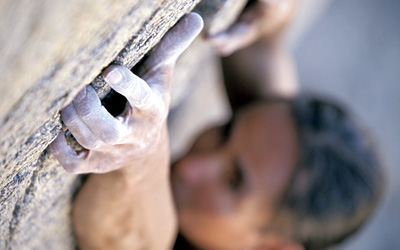
While it stands to reason that rock climbers might harm habitats such as the ancient, stunted forests that grow on cliffs around the world, there has been little unambiguous evidence that this is so. Now the first study to isolate rock climbing from other factors confirms that the sport damages cliff ecosystems.
"Our work clearly shows that rock outcrop ecosystems suffer dramatically when exposed to recreational rock climbing," says Douglas Larson of the University of Guelph in Ontario, Canada. This work is presented in the April issue of Conservation Biology by Larson and Michele McMillan, who is also of the University of Guelph.
The popularity of rock climbing has soared in North America over the last 20 years, disturbing areas that had been untouched for ages. However, previous studies on the ecological effects of rock climbing have been contradictory.
McMillan and Larson studied the ecological effects of rock climbing on vegetation (vascular plants, bryophytes and lichens) on the heavily-climbed limestone cliffs of the Niagara Escarpment, which is near Toronto in southern Ontario. These cliffs have the most ancient forest east of the Rocky Mountains, with eastern white cedars that are more than 1,000 years old. The researchers compared the vegetation on three parts -- the top edge (plateau), the middle (cliff face) and the base (talus) -- of climbed and unclimbed cliffs.
The researchers found that rock climbing greatly decreases the diversity of vegetation on cliffs. Notably, climbed faces had only 4% as many vascular plant species as those that were unclimbed. Moreover, the diversity of bryophytes and lichens in climbed areas were roughly 30 and 40% of that in climbed areas, respectively.
Rock climbing also decreases the cover of vegetation on cliffs. For vascular plants, the cover on climbed plateau and talus was roughly 60% of that on unclimbed areas. For bryophytes, the cover on climbed plateau and talus was about a fifth of that on unclimbed areas. While climbing did not affect the extent of lichen cover, it did change the types of species that grow on cliffs. Delicate lichen species were replaced by tough ones: in unclimbed areas the most common lichens are so fragile that they crumble to the touch, while in climbed areas the most common lichens are so sturdy that they can even withstand rubbing.
McMillan and Larson also found that in climbed areas, the proportion of non-native plants was three times higher (81 vs. 27%). Rock climbing reduces plant density, thus increasing the number of sites where non-native plants can grow. Furthermore, rock climbers can introduce seeds and living pieces of non-native plants via their shoes, clothing and equipment.
To help protect cliff ecosystems, McMillan and Larson recommend banning new climbing routes in protected areas along the Niagara Escarpment, and explaining why to rock climbing associations and schools. "Recreationists are far more likely to abide by management plans when they are aware of the ecological rationale behind the restrictions," say the researchers.